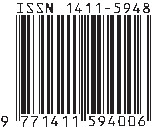MANTRA PETAPA ALAS PURWO: KAJIAN SEMIOTIKA RIFFATERRE
Abstract
Mantra (spell) is the oldest poem in oral literature used as a kind of prayer and hope to God through His creation. This research goals to describe the structure and meaning of the text found in Alas Purwo spells entitled "Restoring magic" using Riffaterre's semiotic theory. Qualitative methods and descriptive analysis are used as research method. The analysis is focused on structural analysis of themes and diction, followed by Riffaterre's semiotic analysis to discuss four things, namely the unsustainability of expression, heueristic and hermeneutic readings, matrices or keywords, and hypograms or intertexts. The results showed that the theme of the mantra is the wish from spell practitioner delivered to the Lord of the universe, while the diction is denotative and connotative. The unsustainable expression in the form of replacement of meaning is found in the use of the synecdoche; deviation of the meaning of the spell, found in the nonsense language style; while the creation of the meaning of spell is dominated by homologues. Heuristic reading uses Indonesian conventions, while hermeneutic reading shows the hope of the spell reader to return the evil magic to its owner. The matrix or keyword in the spell lies in “tekobi bae bae wong kang seja ala maring ingsun”, moreover the spell hypogram is based on verses of the Koran. The meaning of the spell is by having supernatural power, someone is able to restore evil intentions from others under the Creator’s authorization.
SEMIOTIKA has CC-BY-SA or an equivalent license as the optimal license for the publication, distribution, use, and reuse of scholarly work. Authors who publish with this journal retain copyright and grant the journal right of first publication with the work simultaneously licensed under a Creative Commons Attribution-ShareAlike 4.0 International License that allows others to share the work with an acknowledgment of the work's authorship and initial publication in this journal.
Attribution-ShareAlike
CC BY-SA










